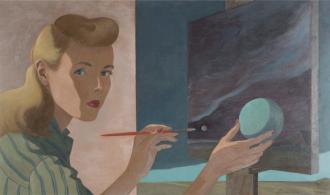The Berkeley Art Museum will forgive you if you have never heard of Dimensionism.
Even the curator of the museum’s new exhibit explains that she first came across mention of the “Dimensionist Manifesto” in 2010, in a book about science and geometry in modern art.
“Dimensionism” is not as obscure as it may sound, certainly not in the Berkeley exhibit from the Mead Art Museum at Amherst College in Massachusetts. It’s an insightful and sometimes delightful collection of almost 70 artworks, from oil paintings and strobe-light photographs to hanging mobiles and sculptures of bronze and string.
That “Dimensionist Manifesto” was written in Paris in 1936 under the leadership of a 31-year-old Hungarian poet and art theorist, Charles Sirato. It called on artists to respond to the scientific revolutions taking place around them, to expand their “dimensions” as the universe seemed to be expanding in scientists’ view.
Some of the era’s leading artists, including Alexander Calder and Marcel Duchamp, endorsed the document, and they’re among the notables in this exhibit, running through March 3.
The show’s subtitle, “Art in the Age of Einstein” gives it a central point of reference. Swirling around it is a variety of artwork showing just how imaginatively art and science could intermix in the first half of the 20th century.
Among the artists are Isamu Noguchi, Man Ray, Helen Lundberg, Sonia Delaunay, even Pablo Picasso, whose 1917 work “Young Girl in an Armchair,” appears here.
The scientific innovators who inspired them? Albert Einstein, of course, whose theory of relativity dated from 1905, plus physicist Linus Pauling and designer Buckminster Fuller, along with lesser-known biologists and astronomers.
But the Berkeley Art Museum galleries aren’t filled with dry scientific dissertations.Hanging from the ceiling is a 1937-38 version of Calder’s mobile “Lobster Trap and Fish Tail.” It’s charming. But it was also an artistic breakthrough for Calder, who’d made similar constructions that simply stood still. Mobiles seemed to fulfill the Dimensionist goal of sculpture that occupied the fourth dimension of space-time.
Helen Lundberg’s 1944 “Self Portrait” looks at first like a standard depiction of an artist at an easel. But her subject is a cosmic landscape, and she seems to hold the planet in one hand. There’s a note that Lundberg took a two-semester biology course years earlier at Pasadena Junior College; later she would co-found the “Post-Surrealism” movement.
Sonia Delaunay’s “Disque,” a gouache-on-paper, plays with brilliant semicircles of red, yellow, blue and black. You can imagine a massive version this work filling the wall of a New York gallery in the 1950s, but “Disque” is not much bigger than 9-by-7 inches and it was painted in 1915.
Isamu Noguchi is practically a performance artist in this exhibit. His black-painted papier-mache sculpture (1944) suggests a double starfish from a distance, but it is “E=mc2,” meant to suggest an atom in mid-burst. Nearby is as fanciful wood-and-wire construction (1943) that attempts to clarify Einstein’s equation. It’s titled “Bucky,” for Noguchi’s friend Buckminster Fuller, who helped explain the Theory of Relativity to him.
Harold Edgerton was a scientist before he was an artist. In his lab he used a stroboscope, its short burst of light capturing 6,000 frames per second. From that beginning, Edgerton produced stop-action photographs revealing what the eye alone could not see. His famous “Milk Drop Coronet” (1936) is on view, along with Herbert Matter’s “East Indian Dancer, Pravina” (1937) with a flurry of strobe-lighted images. Beyond any theory, these photographers captured action in time and space.
Images of the solar system and microscopic details intrigued more artists. Wassily Kandinsky’s lithograph “Stars” (1938) has an amoeba-like shape at the center. Roberto Matta’s “Genesis” (1942) conveys a curved geometry. Laszlo Moholy-Nagy takes science to the destructive extreme with “Nuclear II” (1946), following the atom bomb destruction of Hiroshima and Nagasaki.
Many of these artists are routinely represented in exhibits about Cubism, Surrealism or 1940s and 1950s abstraction. But it’s remarkable how curator Vanja Malloy has brought them together through the “Dimensionist Manifesto.” It seems to be a groundbreaking exhibition, with a fascinating catalog.
Malloy is curator of American art Amherst’s Mead Art Museum, where the exhibit was organized. (It will go on display there in March). Fortunately, the Mead has partnered with UC’s Berkeley Art Museum, where the exhibit is actually getting its premiere. What better place to chart the joint exploration of art and science.
If the Dimensionist movement faded, the kinds of artwork generated by Sirato and his manifesto did not. The exhibit catalog points out that the “golden age” of kinetic sculpture came in the 1950s and 1960s. Even today, holographic art and virtual reality pay tribute to Sirato’s ideas.
“We must accept that Space and Time are no longer separate categories … and thus all the old limits and boundaries of the arts disappear,” Sirato predicted more than 80 years ago. “The new ideology has elicited a veritable earthquake and subsequent landslide in the conventional artistic system.”
Event Information:
What: “Dimensionism: Modern Art In The Age Of Einstein”
When: Through March 3; 11 a.m. to 7 p.m. Wednesdays, Thursdays and Sundays; 11 a.m. to 9 p.m. Fridays and Saturdays
Where: Berkeley Art Museum and Pacific Film Archive, 2155 Center St., Berkeley
Admission: $11 to $13
Information: bampfa.org
